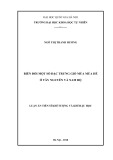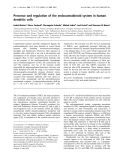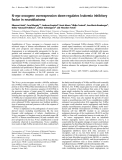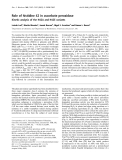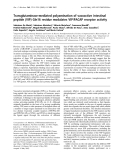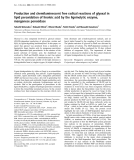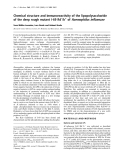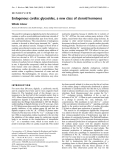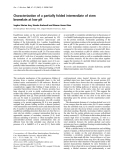
Elucidation of the role of fructose 2,6-bisphosphate in the regulation
of glucose fluxes in mice using
in vivo
13
C NMR measurements
of hepatic carbohydrate metabolism
In-Young Choi
1
, Chaodong Wu
2
, David A. Okar
2
, Alex J. Lange
2
and Rolf Gruetter
1,3
6
Departments of Radiology
1
, Biochemistry, Molecular Biology and Biophysics
2
, Neuroscience
3
, University of Minnesota Medical
School, Minneapolis, MN, USA
Fructose 2,6-bisphosphate (Fru-2,6-P
2
) plays an important
role in the regulation of major carbohydrate fluxes as both
allosteric activator and inhibitor of target enzymes. To
examine the role of Fru-2,6-P
2
in the regulation of hepatic
carbohydrate metabolism in vivo,Fru-2,6-P
2
levels were
elevated in ADM mice with adenovirus-mediated overex-
pression of a double mutant bifunctional enzyme, 6-phos-
phofructo-2-kinase/fructose-2,6-bisphosphatase (n¼6), in
comparison to normal control mice (control, n¼6). The
rates of hepatic glycogen synthesis in the ADM and control
mouse liver in vivo were measured using new advances in
13
C
NMR including 3D localization in conjunction with
[1-
13
C]glucose infusion. In addition to glycogen C1, the C6
and C2–C5 signals were measured simultaneously for the
first time in vivo, which provide the basis for the estimation of
direct and indirect synthesis of glycogen in the liver. The rate
of label incorporation into glycogen C1 was not different
between the control and ADM group, whereas the rate of
label incorporation into glycogen C6 signals was in the
ADM group 5.6 ± 0.5 lmolÆg
)1
Æh
)1
, which was higher than
that of the control group of 3.7 ± 0.5 lmolÆg
)1
Æh
)1
(P< 0.02). The rates of net glycogen synthesis, determined
by the glycogen C2–C5 signal changes, were twofold higher
in the ADM group (P¼0.04). The results provide direct
in vivo evidence that the effects of elevated Fru-2,6-P
2
levels
in the liver include increased glycogen storage through
indirect synthesis of glycogen. These observations provide a
key to understanding the mechanisms by which elevated
hepatic Fru-2,6-P
2
levels promote reduced hepatic glucose
production and lower blood glucose in diabetes mellitus.
Keywords:
1NMR; in vivo; fructose-2, 6-bisphosphate; gly-
cogen; mouse liver.
The regulation of carbohydrate metabolism in the liver is
important for blood glucose homeostasis by controlling
hepatic glucose production. This involves an intricate
regulation of metabolic pathways, such as glycolysis,
gluconeogenesis, glycogenesis and glycogenolysis in the
liver [1,2]. The balance of these pathways is severely altered
in patients with type II diabetes mellitus contributing to
chronically elevated plasma glucose concentrations. There-
fore, an understanding of the regulation of these fluxes can
provide important insights into the mechanisms and poten-
tial treatment of diabetes.
The rates of glycolysis and gluconeogenesis are important
in the rate of hepatic glucose production. Fructose-2,6-
bisphosphate (Fru-2,6-P
2
) plays an important role through
its reciprocal allosteric effects on two critical enzymes,
6-phosphofructo-1-kinase and fructose-1,6-bisphosphatase
(reviewedin[3]).Fru-2,6-P
2
activates phosphofructo-1-
kinase to stimulate glycolysis and inhibits fructose-1,6-
bisphosphatase to reduce gluconeogenesis. Synthesis as well
as degradation of Fru-2,6-P
2
are controlled by the bifunc-
tional enzyme 6-phosphofructo-2-kinase/fructose-2,6-bis-
phosphatase [4,5], providing a switch between glycolytic
and gluconeogenic pathways in the liver [3,6,7]. For
example, when the insulin/glucagon ratio is high, the
enzyme is dephosphorylated at Ser32, its 6-phosphofructo-
2-kinase activity is enhanced and the bisphosphatase activity
is inhibited, resulting in a net synthesis of Fru-2,6-P
2
from
fructose 6-phosphate and ATP [5]. On the other hand, when
the insulin/glucagon ratio is low, 6-phosphofructo-2-kinase/
fructose-2,6-bisphosphatase is phosphorylated by protein
kinase A, which enhances the bisphosphatase activity and
inhibits the kinase activity of the bifunctional enzyme, and
Fru-2,6-P
2
is converted back to fructose 6-phosphate,
thereby producing inorganic phosphate (P
i
)[3].
Recently, we have shown that increasing Fru-2,6-P
2
content via adenovirus mediated 6-phosphofructo-2-kinase/
fructose-2,6-bisphosphatase overexpression reduces hepatic
glucose production and lowers blood glucose in both
normal and diabetic mice [8,9]. The double mutant
bifunctional enzyme used in that study has a mutation of
Ser32fiAla, which prevents cAMP-dependent phosphory-
lation [10], and a mutation of His258fiAla, which
diminishes bisphosphatase activity [11]. While the study
confirmed that increased hepatic Fru-2,6-P
2
content can
reduce blood glucose, it was not clear that the allosteric
effects of this compound on 6-phosphofructo-1-kinase and
fructose-1,6-bisphosphatase could fully account for the
metabolic effects, especially with regard to the glycogen
Correspondence to R. Gruetter, Center for Magnetic Resonance
Research, 2021 6th Street SE, Minneapolis, MN 55455, USA.
Fax: + 1 612 626 2004, Tel.: + 1 612 625-6582,
E-mail: gruetter@cmrr.umn.edu
Abbreviations: Fru-2,6-P
2
, fructose 2,6-bisphosphate; TR, repetition
time; TE, echo time.
(Received 14 March 2002, revised 10 July 2002,
accepted 18 July 2002)
Eur. J. Biochem. 269, 4418–4426 (2002) FEBS 2002 doi:10.1046/j.1432-1033.2002.03125.x

stores. In fact, it was observed that the increased hepatic
Fru-2,6-P
2
was also correlated with an up-regulation of
glucokinase and a down-regulation of glucose-6-phospha-
tase gene expression, suggesting that this biofactor may also
be involved in balancing the uptake and release of glucose
from the liver [8,9].
13
C NMR spectroscopy has been used to measure glucose
and glycogen metabolism in respiring isolated liver cells
[12,13] and perfused liver [12,14–17]. Recently, relative flux
rates have been measured in humans [18–21]. However,
quantification of absolute fluxes in vivo can be complicated
by the fact that no well-defined three-dimensional localiza-
tion method has been used for hepatic studies and by the
limited amount of information available when measuring
the glycogen C1 signal change alone, resulting only in net
glycogen concentration measurements [22]. The present
study presents several advances in the MR technology for
the purpose of measuring hepatic glycogen metabolism.
First, this is the first study to implement and use full three-
dimensional localization of
13
C NMR signals of glycogen in
the intact liver in vivo. Second, during infusion of [1-
13
C]glu-
cose, label incorporation was observed not only into the C1
of glycogen but also the C6, which can only occur by label
scrambling at the level of the trioses. In addition, the signals
of glycogen C2–C5 were detected, possibly reflecting
changes in natural abundance glycogen (i.e. net glycogen
concentration changes). In the present study, we used these
advances in
13
C NMR: (a) to measure the rates of hepatic
glycogen synthesis in normal animals treated with adeno-
virus encoding the double mutant rat liver bifunctional
enzyme in comparison with normal (nondiabetic) control
animals; and (b) to assess the role of hepatic Fru-2,6-P
2
in
controlling glucose and/or glycogen metabolism.
MATERIALS AND METHODS
Animal preparation
The study was conducted according to the guidelines of the
Institutional Animal Care and Use Committee (IACUC) of
the University of Minnesota. Twelve male 129J mice
(Jackson Laboratory, Bar Harbor, ME, USA) were studied
after an overnight fast with access to water (n¼12,
24.7 ± 0.5 g, mean ± SE). Six normal control animals
were studied without any treatment (control group,
23.3 ± 0.2 g body weight). Six mice were treated with an
adenovirus vector containing the cDNA encoding mutant
rat liver bisphosphatase-deficient 6-phosphofructo-2-kinase/
fructose-2,6-bisphosphatase 7 days prior to the study [8] to
overexpress the double mutant rat liver bifunctional enzyme
(ADM group, 26.0 ± 0.5 g body weight).
All animals were initially anesthetized using a bolus
injection of pentobarbital (Abbott Laboratory, North
Chicago, IL, USA) solution (10 mgÆmL
)1
) intraperitoneally
(60 mgÆkg
)1
). Two catheters were inserted into the tail veins,
one for the administration of pentobarbital and one for the
infusion of glucose. A third catheter was placed intraperi-
toneally as an alternative means of glucose administration
should the tail vein fail, which was the case in only three
animals, the data of which were included. After the lines
were inserted, pentobarbital was infused continuously at
4.8–6.0 mgÆkg
)1
Æh
)1
. The animals were secured in a home-
built holder and placed in an acrylic holder attached to an
insert in the gradient coil. Body temperature was maintained
at 37.0 ± 0.5 C with a warm water circulation system
based on a feedback obtained from a temperature probe
placed on the abdomen of the mice (Cole Parmer, Vernon
Hills, IL, USA). 99% enriched [1-
13
C]
D
-glucose (20% w/v
solution, Isotec Inc., Miamisburg, OH) was infused either
intravenously through the tail vein (n¼9) or intraperiton-
eally (n¼3) with an initial bolus of approximately
50 mgÆkg
)1
Æmin
)1
such that blood glucose was rapidly
raised to 10–12 m
M
. Intraperitoneal and intravenous infu-
sion protocols were optimized in benchtop experiments to
provide a similar rise in plasma glucose in the same short
time. The glucose infusion rate was adjusted continuously
thereafter to maintain a stable liver glucose signal.
NMR methods
All experiments were performed on a 9.4 Tesla, 31 cm bore
horizontal magnet (Magnex Scientific), interfaced to a
Varian INOVA console (Palo Alto, CA, USA). An actively
shielded gradient coil (Magnex Scientific, Abingdon, UK)
with an 11 cm inner diameter was used. A custom-built
quadrature
1
H surface RF coil (14 mm diameter) and a
linear three-turn
13
C coil (12 mm diameter) was used as a
transceiver for
1
HNMRand
13
C NMR spectroscopy built
according to a previously described design [23]. A sphere
filled with 99%
13
C enriched formic acid was placed at the
center of the
13
C coil as an external reference and the coil
was placed on the animal’s abdomen directly over the liver.
The position of the liver was identified in gradient-recalled
echo magnetic resonance images (repetition time,
TR
2¼10 ms, echo time, TE
3¼5 ms). The volume of
interest was placed in the mouse liver with typical volume
sizes of 300–430 lL. Three-dimensional localization based
on a recently described method [24] that uses outer volume
saturation ensured complete elimination of signals from
outside of the volume of interest. The localized signals of
glycogen and glucose were acquired with spectrometer
offset set to 100 p.p.m. (64 scans with repetition time,
TR ¼1 s). All data were processed with 15 Hz or 20 Hz
exponential multiplication, zero filling, fast Fourier trans-
formation
4and zero-order phase correction.
Glycogen and glucose resonances were quantified using
the external reference method as described previously
[25,26]. In short,
13
C NMR signals of glycogen and glucose
in vivo were quantified by comparison with the measure-
ments of phantoms containing solutions of 400 m
M
natural abundance oyster glycogen and 0.9 m
M
of 99%
enriched [1-
13
C]
D
-glucose. The phantom measurements
were performed under identical experimental conditions as
the in vivo experiments. Coil loading effects on sensitivity
and radio frequency (RF)
5power were assessed by measur-
ing the 180pulse duration on the
13
C formic acid signal.
Differences in saturation factors including T
1
relaxation and
the nuclear Overhauser effect (NOE) were assessed in vivo
and in phantom experiments.
Assessment of the overexpression of the double
mutant bifunctional enzyme.
The adenovirus infusion resulted in overexpression of the
bifunctional enzyme, which was assessed as described
previously [8]. The bifunctional enzyme was significantly
FEBS 2002 Regulation of hepatic carbohydrate metabolism in mouse liver (Eur. J. Biochem. 269) 4419

increased after tail-vein infusion of adenovirus within 3 days
and peaked between 5 and 7 days post infusion. The
treatment was accompanied by elevated hepatic Fru-2,6-P
2
levels and lowered blood glucose. In addition, liver glycogen
content was reduced in response to the overexpression of
ADM relative to the untreated normal control animals [8].
Because a direct assessment of the ADM or Fru-2,6-P
2
content in the liver requires tissue extraction, indirect
evidence of ADM overexpression in the liver was assessed
prior to the infusion of glucose from the fasting blood
glucose using a glucose oxidase method (Precision glucom-
eter; Medisense Inc. Waltham, MA, USA) and hepatic
glycogen content determined by natural abundance in vivo
13
C NMR spectroscopy (see above). This approach is direct
evidence for overexpression of the bifunctional enzyme,
because the protocol was entirely identical to that used in
our previous study [8,9].
Measurement of the rate of
13
C label incorporation
into glycogen in the liver
Label incorporation into the glycogen C1 reflects glycogen
synthesis via the direct pathway (glucosefiglucose-6-phos-
phatefiglycogen), whereas label incorporation into the
glycogen C6 reflects activity in the indirect pathway due to
label scrambling at the triose level (glucosefiglucose-6-
phosphatefipyruvate (triose level)figlycogen), which is
predominantly a hepatic process. Changes in
13
C-labeled
glycogen C1 and C6 concentration (rate of
13
Clabel
incorporation, D
13
Glyc
1
and D
13
Glyc
6
) were calculated by
linear regression at specific time points. Data points were
calculated from
13
C NMR spectra with a temporal resolu-
tion of 4–8 min as a result of averaging spectra collected
with 1 min temporal resolution.
13
C glycogen changes
were calculated at 2, 3, and > 4 h from the start of
glucose infusion. For the calculation of glycogen C6
changes, data acquired within 1 h of the start of the glucose
infusion was not included to avoid any influence of transient
changes in the isotopic enrichment.
The rates of
13
C incorporation into glycogen were
expressed as a function of precursor metabolite, glucose-6-
phosphate (Glc6P), according to standard tracer methodo-
logy [27]:
d½13Glyc1
dtðtÞ¼Vsyn ½13Glc6P1
½Glc6PðtÞVphos ½13Glyc1
½GlycðtÞ
ð1Þ
d½13Glyc6
dtðtÞ¼Vsyn ½13Glc6P6
½Glc6PðtÞVphos ½13Glyc6
½GlycðtÞ
ð2Þ
Vnet ¼Vsyn Vphos ð3Þ
V
syn
,V
phos
and V
net
represent the flux through glycogen
synthase, phosphorylase, and the rate of net glycogen
synthesis, respectively.
13
Glyc
1
and
13
Glyc
6
represent
13
C-
labeled glycogen C1 and C6 concentration, and
13
Glc6P
1
and
13
Glc6P
6
represent
13
C-labeled glucose-6-phosphate C1
and C6 concentration, respectively. Because the rate of label
incorporation into glycogen C1, the relative isotopic
enrichments of glycogen C1 and C6, and the net glycogen
synthesis rate were measured, Eqns (1), (2) and (3) can be
rearranged to determine V
syn
and the isotopic enrichment of
Glc6Pin terms of V
phos
as:
½13Glc6P1
½Glc6PðtÞ¼
d½13Glyc1
dtðtÞþVphos ½13Glyc1
½GlycðtÞ
Vnet þVphos
ð4Þ
½13Glc6P6
½Glc6PðtÞ¼
d½13Glyc6
dtðtÞþVphos ½13Glyc6
½GlycðtÞ
Vnet þVphos
ð5Þ
For example, V
phos
can be determined by measuring
13
C-
label dilution during unlabeled glucose infusion following
the
13
C-labeled glucose infusion, as we have shown recently
for brain glycogen [26]. Eqns (4) and (5) can be rearranged
to express a relative isotopic enrichment of G6P at the C1
and C6 positions:
½13Glc6P6
½13Glc6P1¼
d½13Glyc6
dtðtÞþVphos ½13Glyc6
½GlycðtÞ
d½13Glyc1
dtðtÞþVphos ½13Glyc1
½GlycðtÞ
ð6Þ
Initially, the enrichment of glycogen is low ([
13
G1yc
6
]/
[Glyc] << 1) and the temporal changes are approximated
by the slope of the linear regression, which can be used to
approximate Eqn (6) as follows:
½13Glc6P6
½13Glc6P1¼
d½13Glyc6
dt
d½13Glyc1
dt
ffi½D13Glyc6
½D13Glyc1½13Glyc6
½13Glyc1ð7Þ
Eqn (7) implies that the initial rate of label incorporation
into glycogen C6 relative to the rate of label incorporation
into glycogen C1 reflects the relative isotopic enrichment of
Glc6Pin the C6 relative to the C1 position. When the
changes in glycogen C1 and C6 are linear with time, the
differentials in the middle part of Eqn (7) can be replaced by
the differences in label incorporation relative to that at time
zero (which is close to zero) resulting in the right-hand
approximation.
RESULTS
Localized
13
C NMR spectra were acquired from the volume
of interest using a three-dimensional localization method.
The location of the volume of interest, with a nominal
volume of 400 lL was based on sagittal and transverse MR
images of the mouse liver (Fig. 1A). Both the reduced blood
glucose (fasting plasma glucose of 5.5 ± 0.3 m
M
in control
vs. 4.1 ± 0.2 m
M
in ADM mice, mean ± SE) and initial
liver glycogen content in the ADM mice were consistent
with bifunctional enzyme overexpression in all experiments.
During infusion of [1-
13
C]
D
-glucose, signals from the
glucose C1 resonances were immediately detected, along
with natural abundance signals from glycerol C1 and C3 at
62.5 p.p.m. (Fig. 1B, bottom trace). Label incorporation
into the glycogen C1 was apparent soon thereafter (Fig. 1B,
middle trace) followed by label incorporation into a
resonance that was clearly resolved from the glycerol C1,
C3 resonance. This resonance was assigned to the glycogen
C6 (Fig. 1B, top trace) based on its chemical shift of
61.4 p.p.m. [28] and that the linewidth was 77 Hz (after
20 Hz linebroadening), which was clearly broader than the
glucose resonances. The nearby glucose resonances were not
4420 I.-Y. Choi et al. (Eur. J. Biochem. 269)FEBS 2002

expected to contribute to the glycogen C6 signal change,
because the continuous infusion of [1-
13
C] glucose will result
in a stable isotopic enrichment for plasma (and liver) glucose
of only a few percentage at C6, leading to a much weaker
signal compared to glycogen C6. The ability to resolve
the resonance of glycerol C1, C3 at 62.5 p.p.m. from the
resonance of glycogen C6 allowed, for the first time, the
measurement of glycogen C6 changes in vivo, which reflects
the indirect pathway.
13
C NMR spectra were acquired while infusing [1-
13
C]
glucose in an ADM mouse over 7.6 h (Fig. 2). The glucose
level in the liver was maintained at 9.7 ± 0.6 lmolÆg
)1
(mean ± SE, n¼6, control mice) and at 9.1 ± 0.5
lmolÆg
)1
(mean ± SE, n¼6, ADM mice) throughout the
experiments. The
13
C-label incorporation into hepatic
glycogen C1 and C6 increased at a nearly constant rate
for the entire measurement period (Fig. 2).
In addition to the signal increases in glycogen C1 and C6,
increased signals were observed in the spectral region from
70 to 78 p.p.m. containing the glycogen C2 through C5
resonances (Fig. 2A), which is enlarged in Fig. 2B. The
increase of these signals is consistent with the spectral
Fig. 1.
1
HMRIand
13
C MRS of the mouse liver. (A) Sagittal (left) and transverse (right) images of the liver of a control mouse acquired using the
FLASH sequence (TR ¼10 ms, TE ¼5 ms). The rectangles indicate the location of the volume of interest, 400 lL(8.5 ·8·6mm
3
). The
13
C-
labeled formic acid sphere can be seen on the left. (B) Three-dimensional localized
13
C NMR spectra were acquired from a nominal 400 lL volume
of the control mouse liver during infusion of [1-
13
C]
D
-glucose. The spectra were acquired 0.1 h (bottom), 1.5 h (middle), and 3 h (top) after the start
of the infusion, and each represents an average over 4.3 min (256 scans, 1 s repetition time). Glycogen syntheses via direct and indirect pathways are
demonstrated from the increases of signal intensities of glycogen C1 and C6, respectively. Data processing consisted of 15 Hz exponential
multiplication, zero filling, FFT and zero-order phase correction. No baseline correction was applied.
FEBS 2002 Regulation of hepatic carbohydrate metabolism in mouse liver (Eur. J. Biochem. 269) 4421

Fig. 2. Hepatic glycogen synthesis with [1-
13
C]glucose infusion in an ADM mouse. (A) The stack plot of
13
C spectra acquired over 7.6 h after
beginning at t¼0 (right scale), the infusion of [1-
13
C]glucose.
13
C-label incorporation into hepatic glycogen was detected in the glycogen C1 and C6
resonances. Net synthesis of glycogen in the liver is visible from the natural abundance signal increase of glycogen C2–C5. The resonance of glycerol
C1 and C3 at 62.5 p.p.m. was resolved downfield from the signal of glycogen C6 at 61.4 p.p.m. (B) The region containing the glycogen C2–C5
signals (from Fig. 2A) was expanded vertically to demonstrate the net synthesis of hepatic glycogen during infusion of glucose. Each spectrum
corresponds to a 17-min acquisition period. Processing consisted of 20 Hz exponential multiplication, with zero filling, FFT and zero-order phase
correction. The spectra are shown without any baseline correction.
4422 I.-Y. Choi et al. (Eur. J. Biochem. 269)FEBS 2002

